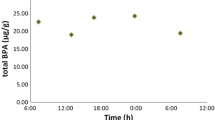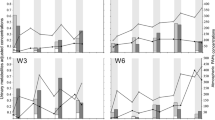Summary
Occupational exposure to p-tert-butylphenol (PTBP) was studied in a workplace where workers were engaged in packing this alkylphenol in bags or transporting the bags by fork-lift. The geometrical mean of eight-hour-time-weighted-average (8 h-TWA) value for personal ambient PTBP level of the packers was 0.39 mg/m3 (n = 15), higher than that of the carriers (0.10 mg/m3, n = 5). Amounts of PTBP collected in the respirators used by the workers were in proportion to the 8 h-TWA values but lower than the estimated theoretical amounts; considerable amounts of PTBP were assumed to be absorbed through the respiratory tract. The urine excreted during the latter half of the shift showed the highest levels of PTBP (geometrical mean: packer, 5.07 μg/ml, n = 20; carrier, 3.03 μg/ml, n = 8). When the workers were away from the workplace, PTBP levels decreased; most was excreted within 24 h. Correlation between the urinary PTBP levels and 8 h-TWA values was significant (r = 0.46, n =19, P < 0.05), but its extent was weak. The total amounts of urinary PTBP excreted for 24 h after the start of the shift were two to three times higher than the estimated respiratory absorption of PTBP; PTBP was assumed to be absorbed not only through the respiratory tract but also through intact skin. It was concluded that the personal ambient PTBP level is not a suitable index for personal exposure, and biological monitoring via the PTBP level in the urine excreted at the end of the each shift is useful for the evaluation of personal exposure.
Similar content being viewed by others
References
Arbeitsstoff-Kommission der Deutschen Forschungsgemeinschaft (Vors., Henschler, D.) (1981) p-tert-Butylphenol, In: Arbeitsstoff-Kommission der Deutschen Forschungsgemeinschaft ed by Gesundheitsschädliche Arbeitsstoffe, Toxikologisch-arbeitsmedizinische Begründungen von MAK-Werten. 8. Lieferung, Verlag Chemie, Würzburg
Ebner H, Helletzgruber M, Hofer R, Kolbe H, Weissei M, Winker N (1979) Vitiligo durch p-tert-butylphenol. Dermatosen Beruf Umwelt 27:99–104
Ikeda M, Hirayama T, Watanabe T, Hara I (1978) GLC analysis of alkylphenols in the urine of workers as a measure to prevent occupational leucoderma. Int Arch Occup Environ Health 41:125–138
Ikeda M, Ohtsuji H, Miyahara S (1970) Two cases of leucoderma presumably due to nonyl or octylphenol in synthetic detergents. Ind Health 8:192–196
Itoh K, Nishitani N, Hara I (1968) A study of cases of leucomeranodermatosis due to phenyl-phenol compounds. Bull Pharm Res Inst 76:5–13
Malten KE, Seutter E, Hara I, Nakajima T (1971) Occupational vitiligo due to paratertiary butylphenol and homologues. Trans St John Hosp Dermatol Soc 57:115–134
Ohtsuji H, Ikeda M (1972) Quantitative relationship between at atmospheric phenol vapor and phenol in the urine of workers in Bakelite factories. Br J Ind Med 29:70–73
O'Sullivan JJ, Stevenson CJ (1981) Screening for occupational vitiligo in workers exposed to hydroquinone monomethyl ether and to paratertiary-amyl-phenol. Br J Ind Med 38:381–383
Author information
Authors and Affiliations
Rights and permissions
About this article
Cite this article
Kosaka, M., Ueda, T., Yoshida, M. et al. Urinary metabolite levels in workers handling p-tert-butylphenol as an index of personal exposure. Int. Arch Occup Environ Heath 61, 451–455 (1989). https://doi.org/10.1007/BF00386478
Received:
Accepted:
Issue Date:
DOI: https://doi.org/10.1007/BF00386478




